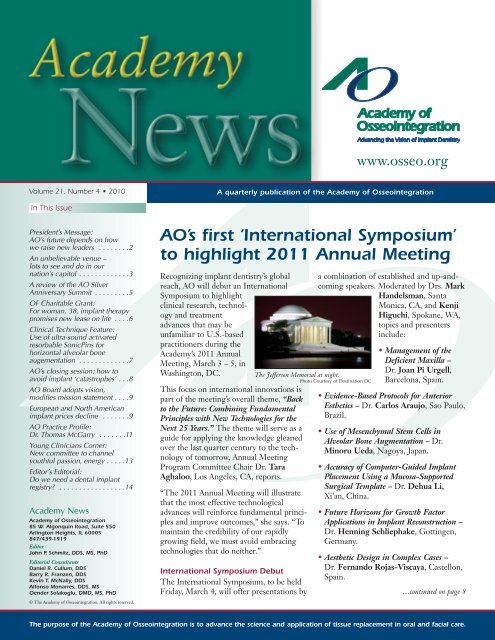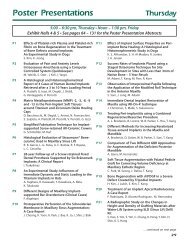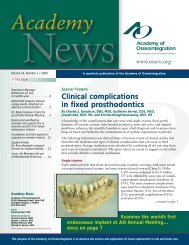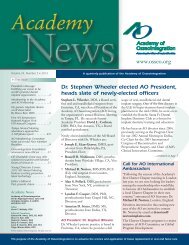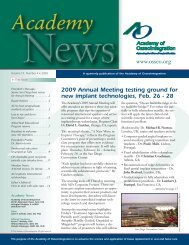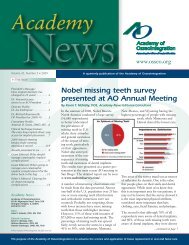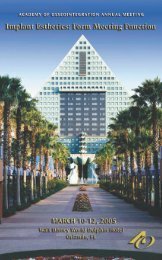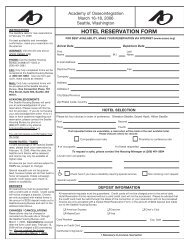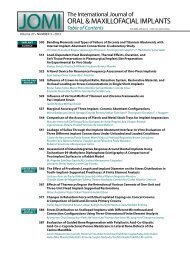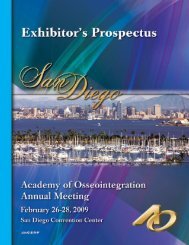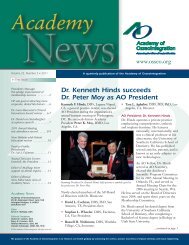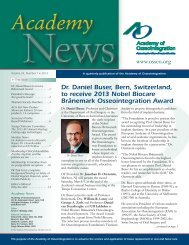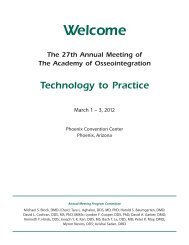International Symposium - Academy of Osseointegration
International Symposium - Academy of Osseointegration
International Symposium - Academy of Osseointegration
- No tags were found...
You also want an ePaper? Increase the reach of your titles
YUMPU automatically turns print PDFs into web optimized ePapers that Google loves.
www.osseo.orgVolume 21, Number 4 • 2010A quarterly publication <strong>of</strong> the <strong>Academy</strong> <strong>of</strong> <strong>Osseointegration</strong>In This IssuePresident’s Message:AO’s future depends on howwe raise new leaders . . . . . . . .2An unbelievable venue –lots to see and do in ournation’s capitol . . . . . . . . . . . . .3A review <strong>of</strong> the AO SilverAnniversary Summit . . . . . . . . .5OF Charitable Grant:For woman, 38, implant therapypromises new lease on life . . . .6Clinical Technique Feature:Use <strong>of</strong> ultra-sound activatedresorbable SonicPins forhorizontal alveolar boneaugementation . . . . . . . . . . . . .7AO’s closing session: how toavoid implant ‘catastrophes’ . . .8AO Board adopts vision,modifies mission statement . . . .9European and North Americanimplant prices decline . . . . . . .9AO Practice Pr<strong>of</strong>ile:Dr. Thomas McGarry . . . . . . .11Young Clinicians Corner:New committee to channelyouthful passion, energy . . . . .13Editor’s Editorial:Do we need a dental implantregistry? . . . . . . . . . . . . . . . . .14<strong>Academy</strong> News<strong>Academy</strong> <strong>of</strong> <strong>Osseointegration</strong>85 W. Algonquin Road, Suite 550Arlington Heights, IL 60005847/439-1919EditorJohn P. Schmitz, DDS, MS, PhDEditorial ConsultantsDaniel R. Cullum, DDSBarry R. Franzen, DDSKevin T. McNally, DDSAlfonso Monarres, DDS, MSOender Solakoglu, DMD, MS, PhD© The <strong>Academy</strong> <strong>of</strong> <strong>Osseointegration</strong>. All rights reserved.AO’s first ‘<strong>International</strong> <strong>Symposium</strong>’to highlight 2011 Annual MeetingRecognizing implant dentistry’s globalreach, AO will debut an <strong>International</strong><strong>Symposium</strong> to highlightclinical research, technologyand treatmentadvances that may beunfamiliar to U.S.-basedpractitioners during the<strong>Academy</strong>’s 2011 AnnualMeeting, March 3 – 5, inWashington, DC.This focus on international innovations ispart <strong>of</strong> the meeting’s overall theme, “Backto the Future: Combining FundamentalPrinciples with New Technologies for theNext 25 Years.” The theme will serve as aguide for applying the knowledge gleanedover the last quarter century to the technology<strong>of</strong> tomorrow, Annual MeetingProgram Committee Chair Dr. TaraAghaloo, Los Angeles, CA, reports.“The 2011 Annual Meeting will illustratethat the most effective technologicaladvances will reinforce fundamental principlesand improve outcomes,” she says. “Tomaintain the credibility <strong>of</strong> our rapidlygrowing field, we must avoid embracingtechnologies that do neither.”<strong>International</strong> <strong>Symposium</strong> DebutThe <strong>International</strong> <strong>Symposium</strong>, to be heldFriday, March 4, will <strong>of</strong>fer presentations byThe Jefferson Memorial at night.Photo Courtesy <strong>of</strong> Destination DCa combination <strong>of</strong> established and up-andcomingspeakers. Moderated by Drs. MarkHandelsman, SantaMonica, CA, and KenjiHiguchi, Spokane, WA,topics and presentersinclude:• Management <strong>of</strong> theDeficient Maxilla –Dr. Joan Pi Urgell,Barcelona, Spain.• Evidence-Based Protocols for AnteriorEsthetics – Dr. Carlos Araujo, Sao Paulo,Brazil.• Use <strong>of</strong> Mesenchymal Stem Cells inAlveolar Bone Augmentation – Dr.Minoru Ueda, Nagoya, Japan.• Accuracy <strong>of</strong> Computer-Guided ImplantPlacement Using a Mucosa-SupportedSurgical Template – Dr. Dehua Li,Xi’an, China.• Future Horizons for Growth FactorApplications in Implant Reconstruction –Dr. Henning Schliephake, Gottingen,Germany.• Aesthetic Design in Complex Cases –Dr. Fernando Rojas-Viscaya, Castellon,Spain.…continued on page 8…continued on page 13The purpose <strong>of</strong> the <strong>Academy</strong> <strong>of</strong> <strong>Osseointegration</strong> is to advance the science and application <strong>of</strong> tissue replacement in oral and facial care.
An unbelievable venue –lots to see and do in our nation’s capitolBy Kevin P. Smith, MBA, Executive DirectorUntil 2011 (March 3-5), the <strong>Academy</strong> <strong>of</strong> <strong>Osseointegration</strong> hadnever held its Annual Meeting in Washington, DC. The reason?The <strong>Academy</strong> wasn’t big enough, according to theWashington DC Convention Bureau.Before an organization can rent out a convention center, itmust guarantee that it will fill a minimum number <strong>of</strong> sleepingrooms at nearby hotels. The <strong>Academy</strong> is a “betweener”—toolarge for most hotel venues, but not large enough to meetmany large city hotel room block guarantees. This may nolonger be the case, as the <strong>Academy</strong>’s Annual Meeting continuesto grow substantially each year.From analysis <strong>of</strong> the early meeting indicators,it appears the Washington, DC meetingwill attract record attendance. At thisearly stage <strong>of</strong> planning, the 26th AnnualMeeting’s exhibit space is almost sold out.In addition, a new, all-time abstract submissionsrecord has been set.Dr. Paul Kamen, New York, NY, Chair <strong>of</strong>the Research Submissions Committee, andhis members are evaluating and selectingthe best submissions for the Oral ScientificResearch and Oral Clinical Research presentations.Dr. Robert Vogel, RanchoSanta Fe, CA, and his Clinical InnovationsCommittee are busy sifting through the abstracts and selecting20 <strong>of</strong> the best abstracts for Friday afternoon’s program.Most people connect George Washington, the father <strong>of</strong> ourcountry, with the convention center, but this historical buildingis named after Walter Edward Washington, the greatgrandson<strong>of</strong> an American slave. He was born in Dawson,Georgia, raised in Jamestown, New York, and later appointedas Mayor-Commissioner <strong>of</strong> Washington, DC, by PresidentsLyndon Johnson (1967–1972) and Richard Nixon(1972–1974).After winning a tight mayoral primary race by only 4,000votes, Washington was later elected by a large majority andbecame the first popularly elected mayor under home rule. Hewas sworn in by Supreme Court Justice Thurgood Marshallon January 2, 1974. The late Mayor’s last public appearancewas at the Convention Center’s grand opening in 2003.Update member contact info at www.osseo.orgHave you recently moved? Do we have your most currentinformation for the Membership Directory? Membersmay update their contact information online atwww.osseo.org, or send an email to Karen Budnik,karenbudnik@osseo.org.The Walter E. Washington Convention Center is a 2.3 millionsquare foot building located in the downtown area. It hashosted many presidential inauguration balls and is certainlylarge enough to facilitate our meeting needs. As a side note,our convention center contacts boast that the Walter E.Washington Convention Center set a Guinness World Recordfor hosting the largest sit down dinner, serving 16,206 guests.If you enjoyed last year’s Friday evening President’s Reception,you definitely don’t want to miss this year’s event, co-sponsoredagain by DENTSPLY, Tulsa Dental Specialties.Registered attendees will board buses from the meeting hotelsthat will take them to the Smithsonian National Air and SpaceMuseum, the most visitedmuseum facility in theworld, attracting on averagemore than nine millionpeople annually. The museummaintains the world’slargest collection <strong>of</strong> historicaircraft and spacecraftamong some 50,000 artifactsthat range in size fromSaturn V rockets to jetlinersto gliders to space helmetsto microchips.The Walter E. Washington Convention Center.Photo Courtesy <strong>of</strong> Destination DCMake sure to see some <strong>of</strong>the major exhibits, including the original 1903 Wright Flyer,Charles Lindbergh’s Spirit <strong>of</strong> St. Louis, Chuck Yeager’s BellX-1, John Glenn’s Friendship 7 spacecraft, and the Apollo 11command module. You can touch a lunar rock and view Earthfrom the open cargo bay <strong>of</strong> the Space Shuttle.Don’t miss the other special events <strong>of</strong> the evening that awaityou in the Lockheed Martin IMAX Theater. Here, films areprojected on the five-story-high screen with six-channel digitalsurround sound. This will be a visual relief after viewingPowerPoint presentations all day. Food stations will be displayedthroughout the area for the entire evening, and attendeeswill also enjoy an evening <strong>of</strong> music for those who justwant to sit down and relax.The <strong>Academy</strong>’s 26th Annual Meeting in Washington, DC,promises to be another crowd pleaser. We encourage you tobring your family and staff and enjoy everything our nation’scapitol has to <strong>of</strong>fer. Meeting registration is now open, so planto register early and take advantage <strong>of</strong> the early registrationdiscount rates. We also anticipate that many <strong>of</strong> our ticketedlectures will sell out early.As you plan your 2011 meeting itinerary, make sure to put theAO meeting at the top <strong>of</strong> your list. We look forward to seeingyou March 3-5 in Washington, DC.3
Clinical Technique FeatureUse <strong>of</strong> ultrasound-activated resorbable SonicPinsfor horizontal alveolar bone augmentationBy Dr. Brenton W. Burger, Sterling, VAHorizontal bone augmentation for the maxillary and mandibularalveolar ridge has been conventionally performed usingmini-stainless steel or titanium alloy screws. The screws areused to fixate cortico-cancellous block grafts to the recipientsite or for tenting the mucoperiosteum to retain particulatebone grafts. Non-resorbable guided tissue regenerative membranesreinforced with titanium have also been developed foruse with particulate bone grafts to augment the alveolar ridge.Resorbable poly-D-L- Lactide pins (SonicPin) have been usedto tent the mucoperiosteum for lateral bone augmentation. Thepin is pushed into a funnel-shaped pilot hole with sonic frequencyvibration. At this time, the edges <strong>of</strong> the pin rub on thebone, causing friction to bring the polymer to a liquid state.The pilot hole is smaller than the pin, causing the polymer t<strong>of</strong>low into the intertrabecular spaces <strong>of</strong> the bone. When thesonic frequency isstopped, these liquefiedportions become hardagain in seconds allowingthe pin to be secure.Figure 1Figure 2Surgical technique inusing SonicPins foralveolar ridge bonegraftingA full thicknessmucoperiosteum incisionis made at the crest<strong>of</strong> the alveolar ridge.Before placing the particulatebone, the recipientsite is trephinatedto enhance the porosity<strong>of</strong> the cortex forosteogenic cells. A1.6 mm diameteradjusted drill is used toprepare the sites for pinplacement. The depth<strong>of</strong> penetration is at leastthrough the outer cortex. TheSonicPin is 7 mm in length by2.1 mm in diameter andplaced 2 mm into the boneallowing approximately 5 mmfor bone graft width (Figure1). Particulate allograft(Puros) is mixed with autogenousbone harvested from thetrephination and placedaround the SonicPin (Figure 2).A guided tissue membrane(OsseoGuard) is placed overthe SonicPin and particulatebone graft. The periosteum isusually incised to allow forprimary closure withoutwound tension. After fivemonths, the grafted bone isacceptable for implant placement.Cone-beam computerizedtomography showsexcellent width <strong>of</strong> augmentedbone (Figure 3, 4 and 5).There are many advantages inusing this technique over conventionalprocedures. A secondsurgical site to harvestdonor bone is not necessary,the SonicPin is extremely easyto place, has excellent stabilityto support the mucoperiosteum,and resorbs after fivemonths preventing an additionalsurgery. The procedurealso provides patients withless recovery time and lesspotential complications.Figure 3Figure 4Figure 5For woman, 38, implant therapy promises new lease on life …continued from page 6ceramometal restorations (Figure 6).Serena says that this treatment has had apr<strong>of</strong>ound positive impact on her life leadingto a new job, renewed energy, closerfamily life and a great attitude. From feelingcursed following several natural disasters,strained family relations and her ownpersonal physical deterioration, Serenanow feels grateful and blessed. She is eternallyappreciative for the gift she wasgiven by the generous contributions bythe AO Foundation, Straumann Inc., andthe team that took care <strong>of</strong> her.OF charitable grants <strong>of</strong> up to $10,000are made directly to member dentists,but the funds may not be applied totheir fees or used for products providedby corporate partners, who receiverecognition for their contributions.Further information about grant applicationguidelines can be found on the<strong>Academy</strong>’s website at www.osseo.org.7
Closing session: how to avoid implant ‘catastrophes‘Catastrophic implant failure will bethe topic <strong>of</strong> the 2011 Annual Meeting’sclosing session, as<strong>Academy</strong> membersand guestsreview MajorCatastrophesand How toAvoid or HandleThem, Saturday,March 5.“Exploring catastrophicfailuresDr. Tara Aghaloohelps to further our pr<strong>of</strong>essional knowledge,since we tend to learn most frommistakes,” explains Annual MeetingProgram Committee Chair Dr. TaraAghaloo, Los Angles, CA. “This sessionwill <strong>of</strong>fer an excellent educationalopportunity for clinicians, whether theyare new to the field or have many years<strong>of</strong> experience.”Attorney Michael Ragan will open theprogram with a presentation on implantclaims, damages and remedies.Other Annual Meeting highlights willinclude:• “Two-Track” Scientific Program –The Surgical Track will explore prostheticconcepts, computer-guidedimplant dentistry, hard and s<strong>of</strong>t tissueaugmentation, and how to determinesuccess. The Restorative Track willcover maxillary overdentures, shortimplants, digital impressions andCAD/CAM restorations, and othersurgical concepts. (Saturday, March 5)• Round Table Clinics – Fifteen separatesessions <strong>of</strong>fer attendees theopportunity to discuss diverse implantdentistry topics – everything fromstem cell-based treatments andadvances in ridge expansion to maxillarysinus augmentation – in small,informal settings with presenters.(Friday, March 4)• Limited Attendance Lectures –Thirteen Limited Attendance Lectureswill increase interaction betweenAnnual Meeting attendees and worldclassclinicians on a range <strong>of</strong> topics.Sessions include implant esthetics,treatment planning for compleximplant restorations, management <strong>of</strong>failed sinus grafts, implant provisionalization,and more. (Friday, March 4)• Corporate Forum – AO’s 2011Corporate Forums will feature manufacturer-hostededucational sessionsthat showcase the latest research,products, techniques and developments.(Thursday, March 3)• Allied Staff Program – The AnnualMeeting’s Allied Staff Programs <strong>of</strong>ferconcurrent sessions designed for dentallab technicians and hygienists. Thedaylong series <strong>of</strong> programs will focuson topics that range from growing asurgical implant practice and contemporaryimplant maintenance toCAD/CAM information and newproducts. (Saturday, March 5)“Allied Staff sessions will emphasize theimportance <strong>of</strong> the team approach topatient care,” Dr. Aghaloo says. “Newtechnologies and clinical applications arebeing introduced at an increasingly rapidrate. It is essential that allied staff pr<strong>of</strong>essionalsunderstand these concepts and howthey apply to implant dental practices.”Complete program and registrationinformation for the 2011 AnnualMeeting is available online at the<strong>Academy</strong>’s Website, www.osseo.org.AO’s First ‘<strong>International</strong> <strong>Symposium</strong>‘ …continued from page 1Point/Counterpoint Approach toImplant ControversiesPoint/Counterpoint sessions will providea forum for spirited debate onTreatment <strong>of</strong> the Esthetic Zone, Friday,March 4. Drs. Michael Norton,London, England, UK, and CraigSirota, New York, NY, will moderate aseries <strong>of</strong> discussions featuring opposingviewpoints on a range <strong>of</strong> topics:• Implant Restorations: Analog vs.Digital Technology – Opposing viewpointson “tried and true” analogtechnology for implant restorationsvs. computer-assisted approaches willfeature Drs. Baldwin W. Marchack(analog) and Christopher B.Marchack, Pasadena, CA, in a debatepitting father against son.• Papilla Augmentation: ProstheticEnhancement <strong>of</strong> S<strong>of</strong>t Tissues –Dr. Christian Coachman, Sao Paulo,Brazil, will outline a three-dimensionalprosthetic reconstruction option toenhance s<strong>of</strong>t tissue architecture. Dr.Sonia S. Leziy, North Vancouver, BC,Canada, will advocate solutions by surgicaland restorative team members.• Traditional Flap Approach vs.Flapless Surgery – Clinical evidencedemonstrating the advantages <strong>of</strong> flaplesssurgery will be presented by Dr.Stephen T. Chen, IV, Melbourne,Australia. Dr. Anthony G. Sclar,Miami, FL, will specify individualcase factors for determining use <strong>of</strong> atraditional flap versus a minimallyinvasive approach.• Immediate Implant ProvisionalRestoration – Dr. Stephen J. Chu,New York, NY, will advocate on behalf<strong>of</strong> immediate placement by addressingcurrent concepts, research and innovations,and how they enhance treatment.• Guidelines for Selecting Implant/Prosthetic Protocols in the EstheticZone – Dr. German O. Gallucci,Boston, MA, will present an analysis <strong>of</strong>clinical considerations within the context<strong>of</strong> their direct application toesthetic implant/prosthetic rehabilitationsand current scientific evidence.The point/counterpoint format will alsodrive debate during the meeting’s openingsymposium, Controversies inImplant Dentistry, Thursday, March 3.“Both the opening symposium andPoint/Counterpoint sessions will featurerespected implant pr<strong>of</strong>essionals debatingongoing controversies, while audiencemembers will engage in the discussionthrough use <strong>of</strong> audience response technology,”Dr. Aghaloo explains.8
AO Board adopts vision, modifies mission statement“To be the world’s premier organizationfor implant dentistry.” That is the newvision statement that will guide the<strong>Academy</strong> for the next 5-10 years, asadopted by the Board <strong>of</strong> Directors at itsOctober strategic planning session.The Board also shortened and simplifiedthe mission statement: “To enhanceoral health globally by advancing thescience, practice and ethics <strong>of</strong> implantdentistry and tissue engineering.”It established many new goals for thenext 18 months, including:• Public Relations: To promote the AObrand to the pr<strong>of</strong>ession and the public.The Board plans to develop amedia relations program to increasepublic awareness <strong>of</strong> the AO and services<strong>of</strong> its members.• Communication: To provide forexchange <strong>of</strong> information. The<strong>Academy</strong> plans to establish communicationsthrough social media andlaunch its new Website before the2011 Annual Meeting.• Membership: To continually add valueto membership, AO will develop awhite paper on a single topic for distributionto the membership, investigatemodels for component chapters,and refine the fellowship program.• Education: To provide educationalprograms that enhance membershipvalue, the <strong>Academy</strong> will develop andprovide an online ADA CERP accreditedcontinuing education programwith assessment for pr<strong>of</strong>essionals and,separately, an online ADA CERPaccredited continuing education programwith assessment for allied staff.Several Board task forces have beenappointed to carry out these initiatives.European and North American implant prices declineBy Emily MacIntosh, Millennium Research GroupThe economic downturn stronglyimpacted consumers and companiesworldwide, and now its effects on thedental implant industry have becomeevident. Since 2009, dental implantprices have declined considerably inboth the North American and Europeanmarkets. This occurred as dentistsattempted to maintain pr<strong>of</strong>itability duringthe economic crisis by increasinglypurchasing implants from low-cost manufacturersand opting to purchase products<strong>of</strong>fered at greater discounts.In most countries, dental implants are anout-<strong>of</strong>-pocket expense for patients, withlittle to no reimbursement from healthcare plans. Consequently, patientsbecame hesitant to undergo dentalimplant surgery during the economicrecession, and dentists were forced toshift their focus.In the past, dentists were mainly concernedabout product attributes and highqualityservice. By 2009, however, therewas a greater importance placed on price,with many dentists switching to lowerpricedmanufacturers such as MISImplants Technologies and ImplantDirect. Industry participants also reportedthat many premium-priced players <strong>of</strong>feredsignificant discounts in order to compete.The focus on price made the dentalimplant market a very attractive arenafor smaller, lower-priced manufacturers,which are <strong>of</strong>ten domestic players. As aresult, the average selling price (ASP)for North American implant fixturesdecreased 4.9%, while the EuropeanASP fell 3.3% over the past year.North America and Europe were notuniformly affected by the economicdownturn, with some countries sufferinggreater hardship than others. Certaincountries, such as the U.S. and Spain,saw average implant fixture selling pricesdecline more severely, by 6.1% and3.7%, respectively, in tandem with theircontracting national economies.In contrast, Luxembourg andSwitzerland experienced no change indental implant fixture ASPs. Prior to theeconomic crisis, these countries sawconsistent, strong ASP growth due totheir rapid adoption <strong>of</strong> new, moreexpensive technologies. Stagnant ASPs,therefore, signaled a hesitancy to adoptthese products given economic uncertainty.However, dental practitionerswere not demanding deep discounts.As the economy improves, the marketswill polarize. Many dentists will beunwilling to return to premium productsbecause procedure prices will have to beincreased to protect pr<strong>of</strong>it margins. Thelow-cost competitors have successfullyleveraged the economic downturn tosecure a permanent position in the market,particularly in well-established areaswhere a large number <strong>of</strong> dentists areplacing implants, such as Germany.Other dentists, however, will return topremium brands that <strong>of</strong>fer the mostadvanced products. Dentists will selectthese manufacturers for their new technologies,strong customer support, andeducational resources.Manufacturers competing in the premiumsegment, such as Straumann andAstra Tech, will garner the most businessfrom dentists new to implantology,because these dentists <strong>of</strong>ten developbrand loyalty for the products they usedduring their education. Manufacturerswho invest in training programs or partnerwith universities will therefore bebest positioned for growth in the premiumsegment through 2014.Emily MacIntosh is an Analyst in theDental and Aesthetics division at MillenniumResearch Group (MRG), in Toronto,Canada. She has researched the global marketsfor dental implants and authored theEuropean and North American reports onthis topic. Her analyses have also been integratedwith MRG’s Perception Pulse projects,which assess the dynamics <strong>of</strong> customer loyaltybehavior in the dental space.9
AO Practice Pr<strong>of</strong>ile: Dr. Thomas McGarryEarly implant pioneer thrives in Oklahoma CityBy Dr. Kevin T. McNally, <strong>Academy</strong> News Editorial ConsultantA pr<strong>of</strong>ile <strong>of</strong> Dr. Thomas McGarry, <strong>of</strong> Oklahoma City, OK,carries particular interest, because he was an original member<strong>of</strong> the implant study club started by Dr. Charlie Berman in1984. It later evolved into what we know today as the<strong>Academy</strong> <strong>of</strong> <strong>Osseointegration</strong>.Dr. McGarry received his dental education at the University<strong>of</strong> Missouri in Kansas City, followed by a ProsthodonticResidency at the Veteran’s Administration Hospital in SanFrancisco.Dr. McGarry’s accomplishments in restorative and implantdentistry are remarkable and exemplify the pedigree <strong>of</strong>excellence that we have come to experience in the members<strong>of</strong> the <strong>Academy</strong>. He has chaired all <strong>of</strong> the positions <strong>of</strong> theAmerican College <strong>of</strong> Prosthodontics, and served as President<strong>of</strong> the College’s Foundation, where he developed its successfuldevelopment campaign.An active committee member <strong>of</strong> AO, he has also held membershipsin most national prosthodontic groups and theAmerican Dental Association. He maintains a daily prosthodonticpractice with his two partners, Drs. Lars Bouma andSusan Brackett, and provides leadership in two educationalendeavors that have won high praise from attendees: McGarryImplant Institute and the Oklahoma City “OKC” Study Club.His commitment to implant dentistry was the creative forcebehind the McGarry Implant Institute, which is directed byhis wife, Gretchen. Her background in nursing educationhelps in creating cutting edge auxiliary education programsthat are integral to the Institute’s teaching program.The McGarry practice facility boasts a12-station teaching laboratory,a state-<strong>of</strong>-the-art surgical suite with full audio/visualcapacity in the conference/lectureroom, and a staff <strong>of</strong>educators fromaround the UnitedStates, includingPhD anatomist Dr.Dan O’DonoghueThe McGarry Implant Institutefrom the University <strong>of</strong>Oklahoma.They provide smallgroup, hands on trainingfor implant placementand restorationfrom a prosthodonticperspective, utilizingfresh frozen humancadaver specimens, full The McGarry teaching method in action.pre- and post-surgicalCone Beam CT imaging <strong>of</strong> the cadavers, and classroom/discussiontime over several weekends. These programsculminate in the placement <strong>of</strong> implants in live patients by the“student” doctors, mentored by this talented team <strong>of</strong> educators.An interesting benefit <strong>of</strong> the McGarry teaching methodis the continuing follow-up by mentors, as the “students”incorporate the implant process into their daily practices.Additionally, as if running a practice and a teaching facilityweren’t enough, Dr. McGarry created the Oklahoma City“OKC” Study Club. It meets evenings once a month, coveringbroader topics <strong>of</strong> interest to members comprised <strong>of</strong> local dentistsin the Oklahoma City area. This study club presentsspeakers from many dental disciplines, including dentalimplants, and attracts 25-30 regular members to the two-hourdinner meetings.Happily married since dental school to Gretchen, they parentfour children, son Andrew (currently in dental school), daughtersT.J. and Nicole, and nephew Kevin, whom they haveraised as part <strong>of</strong> the family.Dr. McGarry says that when he and Gretchen decided to settlein Oklahoma City after his residency in San Francisco, thecommon response to the move was that it was a little bit “<strong>of</strong>fthe radar” for his practice. Yet his accomplishments both personallyand pr<strong>of</strong>essionally attest that pr<strong>of</strong>essionalism and quality<strong>of</strong> service are good measures <strong>of</strong> success, no matter whereyou hang your shingle. <strong>Academy</strong> News is happy to highlight Dr.McGarry and <strong>of</strong>fer an inside look <strong>of</strong> one <strong>of</strong> the many accomplishedmembers <strong>of</strong> your <strong>Academy</strong>.President’s Message …continued from page 2The <strong>Academy</strong>’s Annual Meeting is theonly place where you can meet andgreet the leaders <strong>of</strong> implant dentistryand get the latest research, information,and training. The program serves theneed each <strong>of</strong> us has to constantly seeknew knowledge and continue our educationin implant dentistry, so that wemay deliver state-<strong>of</strong>-the-art services toour patients. Attending the AnnualMeeting gives you a competitive edge inpractice. There can be no doubt aboutthat. Don’t miss the learning and fellowshipopportunities we have preparedfor you.I invite you to be with us inWashington.11
Young Clinicians Corner:New committee to channel youthful passion, energyBy Drs. Joan Pi-Anfruns and Andrea Henderson, Co-Chairs, Young Clinicians CommitteeAs we step into a new decade, we celebrate25 years in the life <strong>of</strong> the <strong>Academy</strong><strong>of</strong> <strong>Osseointegration</strong>. In its 25-year history,this organization has become a leadingreference in the field <strong>of</strong> implant dentistry.It all began with the formation <strong>of</strong> alocal study club by a group <strong>of</strong> enthusiasticclinicians who wanted to share information.They soon realized that it wasnot enough, and that in order toadvance in research and education, theywould have to expand to a nationallevel. The <strong>Academy</strong> <strong>of</strong> <strong>Osseointegration</strong>held its first meeting in 1986. Sincethen, it has grown to over 6,000 membersfrom 70 countries.We believe that the <strong>Academy</strong> <strong>of</strong><strong>Osseointegration</strong> has the potential togrow even more and secure its positioninternationally as the leading organizationin implant dentistry.Today, a new generation <strong>of</strong> young andenthusiastic clinicians have gatheredtogether. At AO’s recent AnnualMeeting in Orlando, a proposal wasmade to the Advisory Committee onCommittees (ACC) to create a newcommittee, the Young CliniciansCommittee (YCC).As residents, we have seen over the pastfew years that there is no specific platformor venue where young clinicianscan interact and use their passion andenergy to the benefit <strong>of</strong> AO.Tomorrow’s leaders in implant dentistrywill come from today’s young pr<strong>of</strong>essionals.That’s why a new AO committeeis being organized to work towards theDr. Joan Pi-AnfrunsDr. Andrea Hendersoneducation and mentoring <strong>of</strong> youngerpr<strong>of</strong>essionals. Our mission is to guaranteethe progression <strong>of</strong> leadership in AOand assure the progress and development<strong>of</strong> the <strong>Academy</strong>’s strategic plansand worldwide recognition.The aims <strong>of</strong> the YCC will be to assistthe AO Board in the specific tasks thatmight be required and participate in itspr<strong>of</strong>essional and social functions. Wewill work with other committees todevelop new ideas and projects inorder to increase awareness for AO’scommitment to its mission statement:“To enhance oral health globally byadvancing the science, practice andethics <strong>of</strong> implant dentistry and tissueengineering.”We want to expand the young clinician’sknowledge, understanding and practicalskills in implant dentistry; and promotethe exchange <strong>of</strong> knowledge and researchbetween experienced clinicians, who areAO leaders, and younger members.The YCC is open to any AO memberwho is currently attending, or hasrecently completed a post-doctoral program(no more than 5 years post-doc) inthe field <strong>of</strong> implant dentistry and isactive in clinical practice, research, oreducational institutions. Any AO memberwho fits this description is welcometo participate. If you are interested,please contact the YCC at aoycc10@gmail.com.There are exciting times ahead <strong>of</strong> us, andthis is only the beginning. The YCC isexcited to bring a fresh outlook and newideas to an already world-renownedorganization. We are looking forward tolearning from our mentors and continuingthe excellence that AO has to <strong>of</strong>fer.We hope that this committee will be aplatform for young leaders to gainknowledge and share their enthusiasm tobenefit AO and its members.We are looking forward to working withall <strong>of</strong> you.Editor’s Editorial …continued from page 14fill out a dental implant survey for ahealth care dental implant companyevery month and it takes two minutes t<strong>of</strong>ill out. So, it can be done.However, if the registry gets patient specific,then HIPPA compliance wouldneed to be in place. This is all possible, ifthe time is taken to repeatedly modify theregistry forms during the “beta” phase.As this editorial was going to press, Ilearned that the AO has decided not toproceed with an implant registry at thistime. The AO Board <strong>of</strong> Directors understandsthat the issue <strong>of</strong> establishing animplant registry is complex and overlapswith multiple agenda and regulatoryissues. Other, larger dental organizationshave tried to tackle this issue but thendecided not to pursue it, due to logisticaland legal problems. The AO Boardagreed to continue with further discussionand exploration <strong>of</strong> the registry issueand keep its options open.In my opinion, it is an issue that deservesfurther discussion. Some day, some way,it needs to get done!References1US Slow to Establish Implant Registry,http://www.memphisdailynews.com/editorial/Article.aspx?id=48431The Editor’s Editorial is intended to contributeto the dialogue on issues important to implantdentists. The views expressed in the editorial donot necessarily reflect the policy <strong>of</strong> the <strong>Academy</strong><strong>of</strong> <strong>Osseointegration</strong> or its Board <strong>of</strong> Directors.Readers who would like to comment or express apoint <strong>of</strong> view on the editorial are invited towrite via e-mail to the editor at schmitzjp@hotmail.com. We will endeavor to publish pertinentcomments or views when space permits.13
Editor’s EditorialDo we need a dental implant registry?By John P. Schmitz, DDS, MS, PhD, Newsletter EditorAs <strong>of</strong> today, I’ve written ten editorials,and have two editorials left before retiringfrom this very prestigious position.Words cannotexpress howmuch I willgreatly miss thisaspect <strong>of</strong> my pr<strong>of</strong>essionallife. Ithas been veryrewarding.I am in theprocess <strong>of</strong> introducingtwo newDr. John Schmitzfeatures before I retire. One will be theYoung Clinician’s Corner, where this newcommittee will introduce the AO membersto young dentists and future leaders<strong>of</strong> the <strong>Academy</strong>. It is introduced in thisissue and features two outstanding leadersfrom UCLA, Drs. Joan Pi-Anfrunsand Andrea Henderson, who broughtthis idea to the table for the AO. Theyshould be congratulated on their innovationand vision.The other new feature will be on theBusiness <strong>of</strong> Implant Dentistry, where memberscan submit their ideas on how todecrease overhead and improve pr<strong>of</strong>iciencyin implant dentistry (I could writea book on this). Please submit your ideasto me by email. I am eager to hear them.The topic <strong>of</strong> this editorial is an assessment<strong>of</strong> the need for establishing a dentalimplant registry. The idea is not new.Tracking surgically implanted materials,whether they are metal (dental or orthopedic)or allogeneic products (dermis,bone, etc.), is also not new. I alwaysmodel the orthopedic industry for many<strong>of</strong> the controversial issues we have indentistry and fail to recognize (likeimplants, TMJ, etc.). An implant registryis a prime example.For instance, orthopedic hip implants areone <strong>of</strong> the most expensive surgical productsin the healthcare industry. There isan intense desire to optimize their success.It has been suggested: “Medicarecould save as much as $1 billion/year bytracking the success/failure <strong>of</strong> orthopedicimplants and…by using that informationcould lower the rate <strong>of</strong> revision surgeries.” 1The U.S., unlike Australia, Canada, and agrowing number <strong>of</strong> European countries,currently has no national registry for hipand knee implants. However, in Sweden,a total joint registry was established in1979. Since then, Sweden’s surgical revisionrate from 1992-2000 was 6.4%. Bycomparison, U.S. Medicare recorded arate <strong>of</strong> 16.9%. Was this difference due toSweden’s implant registry?A 2% decrease in the U.S. revision ratecould save $652 billion/year! Could thismean that the Centers for Medicare andMedicaid Service (CMS) will eliminatethose companies, and possibly surgeons,in the health care system whose implantsfail more than others? Is that a badthing? I’m not sure. So read on.In some circles, an implant registry,although voluntary, already exists. Forinstance, a “TMJ Implant Registry” currentlyexists. Participation is voluntary.On a larger scale, the U.S. orthopedicindustry has been struggling with establishingan implant registry for manyyears. Currently, major orthopedicindustryimplant makers are supporting aproject aimed at tracking hip and kneeimplants in 90% <strong>of</strong> U.S. hospitals.In 2009, the American <strong>Academy</strong> <strong>of</strong>Orthopaedic Surgeons created theAmerican Joint Replacement Registry totrack implants. The goal is to allow companiesto track issues related to orthopedicimplant failures before they“explode” into large-scale Food & DrugAdministration (FDA) recalls.We as doctors have taken oaths touphold the safety <strong>of</strong> our patients. Assuch, it is our obligation to report devicefailures (data the FDA collects and mayuse to recall a device). Increasingly, dentalimplant companies are reluctant toprovide us with replacement dentalimplants, or to limit the number <strong>of</strong>replacements, if there is a failure.Furthermore, there are <strong>of</strong>ten times whena dental implant does fail catastrophically.This can happen when an abutmentfractures, or a zygoma implant fractures,or the implant table/connection isdeformed during insertion. Many timesthis is only discussed within the Internetimplant blogs, but it does occur. If thishappens to you, please report it to theFDA. This can be done online at:http://www.fda.gov/Safety/MedWatch/HowToReport/default.htm.What are the advantages <strong>of</strong> a dentalimplant registry? First, it is good forpatient care. It helps us identify, althoughnot with a great degree <strong>of</strong> certainty,whether the operator or the implantfailed. It may also help us identify if certainimplant surfaces or designs are betterthan others.Second, it may provide an easily searchabledatabase to assist in dealing withreplacement components, duration <strong>of</strong>service, success, product identification,etc. All <strong>of</strong> us have had the problem <strong>of</strong> apatient having an implant placed inanother geographic region 10 years agoand walking into the <strong>of</strong>fice to have aPhase II surgery, to have an abutmentplaced, or to have a crown remade.The <strong>of</strong>fice now struggles with the company<strong>of</strong> origin, date <strong>of</strong> surgery, etc. Howeasy would it be if you could just goonline, sign into a database, and bring upthe implant placement data and componentspecifications? If this would happen,it would be possible to track and comparefailure rates.If an implant registry could be developed,it would be a great service. Inaddition, it could then be possible to validatesuccess rates <strong>of</strong> different implantsand implant companies. I’m not sureeveryone wants this kind <strong>of</strong> data released.Would the AO lose sponsors if we publishedthis kind <strong>of</strong> information?One <strong>of</strong> the biggest criticisms in developingany dental implant registry is theorganization <strong>of</strong> the “form” to fill out. Ifit is a lengthy or detailed implant survey,some doctors may not use it. I currently…continued on page 1314
OsseoSpeed TX—Growing power from Astra TechNOW WITHTAPERED APEXOsseoSpeed TX implantsAt Astra Tech Dental we continuously strive to enhance products andsimplify procedures to provide reliable long-lasting successful resultsand, at the same time, make your day-to-day work a little bit easier.OsseoSpeed TX is designed to do just that: Superior long-termbone maintenanceIn more than 40published articles*,the mean marginalbone level reductionwhen using the Astra Tech Implant Systemis only 0.3 mm during the first year <strong>of</strong>loading and stable thereafter. This result isat least four times better compared to thecurrent standard norm <strong>of</strong> 1.5 mm <strong>of</strong> boneloss after five years.*References available upon request.
Want More?Solutions StartHere!Introducing Solutions For Success• Comprehensive Treatment Solutions• Enhanced Knowledge Solutions• Business Excellence SolutionsEnhancedKnowledgeComprehensiveTreatmentBusinessExcellenceProviding Solutions – One Patient At A Time Our Solutions Offer:• Patient Driven Implant Systems• End-To-End Prosthetic Solutions• Site-Specific RegenerativeOptions• Comprehensive EducationalContinuum For All Levels Of Expertise• Diversified Delivery Options• Audience-Specific Program Options• Patient Recruitment Support• Business Efficiency Support• Practice Growth SupportCall Your BIOMET 3i Representative Today To Find Out How We Can HelpYou Provide Solutions – One Patient At A Time. In The USA: 1-800-342-5454.Outside The USA: +1-561-776-6700 Or Visit Us Online At: www.biomet3i.comProviding Solutions – One Patient At A Time and design are trademarks <strong>of</strong> BIOMET 3i LLC. BIOMET 3i and designare trademarks <strong>of</strong> BIOMET, Inc. ©2010 BIOMET 3i LLC. All rights reserved.
© Nobel Biocare Services AG, 2010. All rights reserved. Nobel Biocare, the Nobel Biocare logotype and all other trademarks are, if nothing else is stated or is evident from the contextin a certain case, trademarks <strong>of</strong> Nobel Biocare.NobelReplace TMThe world’s most used implant system. *Internal tri-channelconnection for accurateand secure prostheticrestorations.TiUnite® surface and Groovyto enhance osseointegration.Implant design that replicatesthe shape <strong>of</strong> natural tooth roots.* Source: Millennium Research GroupColor-coded system foraccu rate and fast componentidentification and ease <strong>of</strong> use.Color-coding: step-by-stepdrilling protocol for predictablesurgical procedures.NEWNow also availablein 11.5 mm lengthVersatility, ease-<strong>of</strong>-use and predictabilityhave made NobelReplaceTapered the most widely usedimplant design in the world.*NobelReplace Tapered is a generaluse, two-piece implant system thatperforms both in s<strong>of</strong>t and hard bone,one- and two-stage surgical procedures,while consistently deliveringoptimal initial stability. NobelReplaceTapered is a system that grows tomeet the surgical and restorativeneeds <strong>of</strong> clinicians and their patients– from single-tooth restorations tomore advanced multi-unit solutions.Whether clinicians are just startingor are experienced implant users,they will benefit from a system thatis unique in flexibility and breadth<strong>of</strong> application.Nobel Biocare is the world leaderin innovative and evidence-baseddental solutions.For more information, contact aNobel Biocare representative at800 322 5001 or visit our website.www.nobelbiocare.comNobel Biocare USA, LLC. 22715 Savi Ranch Parkway, Yorba Linda, CA 92887; Phone 714 282 4800; Toll free 800 993 8100; Tech. support 888 725 7100; Fax 714 282 9023Nobel Biocare Canada, Inc. 9133 Leslie Street, Unit 100, Richmond Hill, ON L4B 4N1; Phone 905 762 3500; Toll free 800 939 9394; Fax 800 900 4243Disclaimer: Some products may not be regulatory cleared/released for sale in all markets. Please contact the local Nobel Biocare sales <strong>of</strong>fice for current product assortmentand availability.


